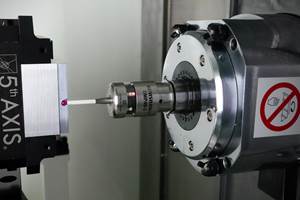The Modular Multi-Gage Concept
Modular, multi-gage measuring devices work with a wide range of workpieces and and are ideal for short-run production in which flexibility and change-over are key.
The idea of the multi-gage is to take all of the elements found in high-precision comparative gaging and turn them into modular components. When looking at the parts of a comparative gage, it is easy to see that there are very basic components common to them all. For example, good comparative gages have solid reference anvils (or contacts), a sensitive contact, part references (backstops) and a readout, all tied together with a robust frame for stability.
The use of these standard components enables multi-gage measuring devices to be designed and assembled for the widest possible range of workpieces. Whether the workpiece is a basic shaft with just a couple of diameters or a complex transmission shaft with multiple diameters using differential probes, concentricity and length of the final configuration comes down to selecting the right standard elements to complete the measuring task. Since the accuracy is built into the components, all of the alignment relationships are inherent, leading to fast assembly and high performance.
Multi-gages also can easily be reconfigured for similar or different applications, as they are constructed of all common elements. So, where a traditional comparative gage may have been built for one shaft of a certain size that has five diameters, a new multi-gage can easily be adjusted for five different shafts having different diameters at different locations.
Flexible gaging would be even better with a flexible gaging instrumentation package, such as a PC-based workstation or an industrial tablet that could store all the various programs for the parts to be measured. However, there needs to be more than just the gaging computer to measure and store the data. All information from the probes and sensors used in the flexible gaging must reach an interface that enables the user to make gaging decisions. Just like standard mechanical elements for diameters, runouts and lengths, there are standard electronic modules for linear variable differential transformers (LVDTs), digital probes and air sensors to gather dimensional information from the fixture to be used on the gaging computer.
If the operator needs classification of the parts through signal, lights or indications for sorting, there are often I/O modules available as part of these custom-configuration systems. Just like the mechanical modules in which the locating and positioning mechanisms are built in, the same is true with the modular systems available today. Most snap and lock together in various configurations in a simple plug-and-play manner and are connected to the gaging computer through a standard interface module.
The combination of module-standard mechanical elements, interchangeable electronic modules and a simple-to-use gaging computer interface is ideal for shops specializing in short runs where flexibility and change-over to new parts are key for business.
With the modular program in place, gage reconfiguration would simply involve reconfiguring the gage to the new part with the mechanical and electronic elements, then selecting the correct part program to run the new series of parts. This ties in perfectly with the same concept in manufacturing: Use the same machine to produce similar parts with fast and easy change-overs via a new set of preset tooling and a new part program.
Thus, while the machine operator changes tooling and reprograms the machine for the new part, the gage technician resets the modular-gaging elements to the new part and selects the correct gaging program.
Whether measuring an outside diameter, inside diameter or length, the modular multi-gage elements can be configured for simple parts to complex workpiece geometries. A number of measuring points can be inspected within a small area of the workpiece because the modular components are all designed to be as small as possible.
Just as there are different levels of performance and robustness in the design of standard handheld comparative gaging, modular multi-gage components employ a similar design philosophy. Should the tolerance on the part be fairly “wide open,” there is a modular element that can accomplish the task with the proper level of precision and value. However, should the manufacturing process be in a relatively harsh environment with tight tolerances, there are elements and gaging techniques available to meet these needs as well.
Related Content
What Should Machinists Know About In-Machine Probing?
In-machine probing doesn’t reach the power of CMMs but can still be useful for pre- and mid-process control, as well as for “rough screening” of parts.
Read MoreDetermining Out-of-Roundness at the Point of Manufacture
George Schuetz, Mahr Inc.’s Director of Precision Gages, offers these techniques for measuring roundness on the shop floor.
Read MoreHow to Choose the Correct Measuring Tool for Any Application
There are many options to choose from when deciding on a dimensional measurement tool. Consider these application-based factors when selecting a measurement solution.
Read More5 Things CNC Operators Must Know About Sizing Adjustments
For CNC operators, sizing adjustment is an essential skill. Keep these points in mind when training new CNC users.
Read MoreRead Next
The Cut Scene: The Finer Details of Large-Format Machining
Small details and features can have an outsized impact on large parts, such as Barbco’s collapsible utility drill head.
Read More3 Mistakes That Cause CNC Programs to Fail
Despite enhancements to manufacturing technology, there are still issues today that can cause programs to fail. These failures can cause lost time, scrapped parts, damaged machines and even injured operators.
Read More


























